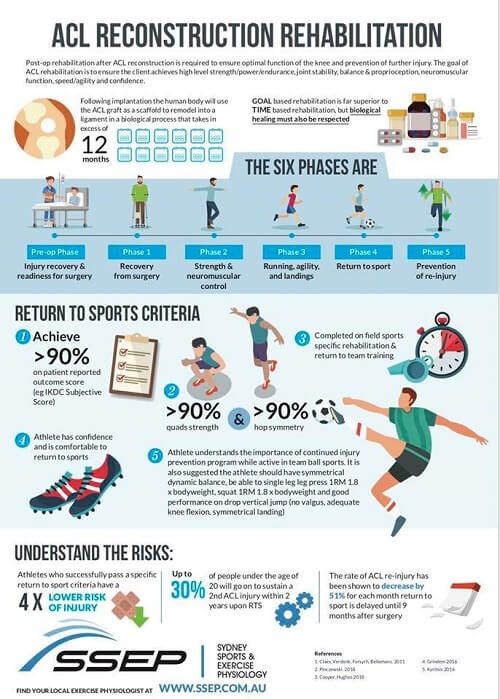After surgery, it is important to allow the ACL to heal properly. To do so you need to follow doctor’s orders and incorporate ACL rehab exercises. At Sydney Sports & Exercise Physiology, we believe that goal based rehabilitation is far superior to time based rehabilitation. We will work directly with you to help you reach your goals.
A torn ACL is a severe knee injury that requires surgery to repair. The torn ligament is often repaired with ACL reconstruction surgery. During the surgery the damaged ligament is replaced with new ACL graft tissue. This tissue can be taken from the patient’s body or a donation from someone else. It can take more than 12 months for the ACL graft to remodel into a ligament.

Pre-op Phase – Injury Recovery & Readiness for Surgery
The pre-op phase gets you ready for surgery. Having physical therapy before your surgery has been proven to improve the outcome.
Check out our rehabilitation services.
Phase 1 – Recovery from Surgery
The first phase after ACL reconstruction is recovery. It usually lasts for 2 weeks. This time is critical because your body is most susceptible to further injury. ACL surgery affects your muscles, ligaments, and other tissues which leads to inflammation. After surgery, you will probably have excess fluid buildup around your knee and experience pain and swelling.
ACL rehabilitation will start immediately after surgery. More than likely you will be given a list of small ACL exercises to perform daily. It is important that you do not put any weight on the leg because it can cause damage. You will need to limit your mobility and use crutches when you are up.
Phase 2 – Strength & Neuromuscular Control
During phase two you should be able to bear weight on the leg. Activity still needs to be limited because the tissues are still healing.
During ACL rehab your therapist will focus on regaining your full range of motion. You may need to wear a protective brace because your knee is still susceptible to injury.
Once your knee begins to heal, you will be able to incorporate low-impact activities.
Phase 3 – Running, Agility and Landings
By the time you get to stage 3, you should be able to incorporate more sport specific training. You will need to continue the recommend ACL strengthening exercises to help prevent future injuries. It is often recommended that you continue wearing a knee brace during this phase.
Phase 4 – Return to Sport
After six months you should be able to return to sports. Your physical therapist will work with you to determine if all criteria has been met. Damaged tissue needs to be fully healed. Some doctors recommend that you continue to wear your brace for two more years.
To return to sport you need to be confident and comfortable. You also need to understand injury prevention. Our physiologists will work with you to improve your strength and symmetrical dynamic balance.
Phase 5 – Prevention of Re-injury
Re-injury always remains a risk factor. Studies have shown that during the first 2 years after surgery you are 6 times more likely to suffer ACL injury than those who have never been injured.
To prevent re-injury you should take part in an ACL rehabilitation injury prevention program. At Sydney Sports & Exercise Physiology, we know how to strengthen muscles and prevent future injuries. We will work with you to improve you performance, power, and strength.
Understanding the Risks
Knowing what to expect will help you have a better understanding of what you will be dealing with.
By following through with all the phases of ACL rehab and passing specific return to sports criteria you will have a four times lower risk of re-injury.
Up to 30% of athletes under the age of 20 are more likely to sustain a 2nd ACL injury within 2 years of returning to sports.
If return to sport is delayed for nine months after surgery, the injury rate decreases by 51%.
We Can Assist You
At Sydney Sports & Exercise Physiology, our experienced exercise physiologists can assist you in returning to your everyday activities after an ACL injury. Call one of our 9 convenient locations to schedule your ACL rehab.
